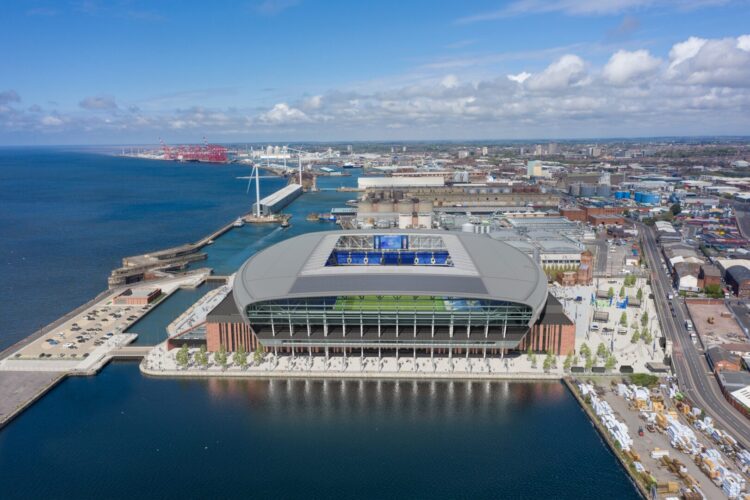Planning officials in Liverpool are recommending approval for Everton’s £500m new stadium at Bramley Moore Dock and construction work could start in the spring. Tony McDonough reports

Construction work on Everton Football Club’s new £500m stadium in Liverpool’s northern docklands could begin in weeks after city planning officials recommended its approval.
On Tuesday, February 23, councillors on Liverpool City Council’s planning committee will meet to decide if the arena at Bramley Moore Dock can go ahead. With planning officers recommending approval it seems almost certain the development will get the green light.
Liverpool City Council released its detailed report into the scheme at Liverpool Waters on Monday afternoon. It would see Everton leave its current home at Goodison Park to move into the 52,888-capacity stadium on the waterfront. The report reveals that Everton looked at 52 separate sites in the city and that this was the only suitable location.
Build time for the stadium is 150 weeks and will take place in 12 stages. This means it is unlikely the original plan that Everton would kick-off the 2023-24 season in the new arena will happen. A more realistic target is the 2024-25 season.
Click here to read the full council report
The club is keen to avoid the same mistake made by Tottenham Hotspur which set opening deadlines that it was unable to meet. Everton is mindful that projects of this size and complexity can suffer delays for multiple reasons.

LBN understands that a financial backer for the scheme has been lined up and Everton is “confident” funds will be released when the stadium is given the official go-ahead. Everton is no longer considering a plan put forward by Liverpool Mayor Joe Anderson for the city council to borrow money to put towards the project.
Once the planning committee gives the go-ahead it will then be referred to the Secretary of State for Housing, Communities and Local Government, Robert Jenrick, who will review the application. This process typically takes no more than 21 days although it can take a little longer.
This procedure is standard for a project of this size and does NOT mean it is being “called in” by the Secretary of State. That would normally only happen if he decides the application conflicts with national planning policy.
As expected, the council report confirms that UNESCO, Historic England, and the Victorian Society have all objected to the stadium. UNESCO is concerned about the impact it would have on the waterfront World Heritage Site (WHS).
This is the latest in a series of skirmishes between the city and UNESCO with the latter threatening to withdraw WHS, a stance that has angered Joe Anderson and figures in the city’s businesses community. Peel L&P, the owner of Liverpool Waters, has made amendments to the masterplan of the £5bn scheme in an attempt to placate UNESCO.
Historic England, and the Victorian Society both concede that that stadium plan offers considerable public benefit. However, they are both concerned that it will lead to the Victorian Bramley Moore Dock, designed by Jesse Hartley and opened in 1848, being filled in.
In a report last year, Historic England said: “We consider that the proposal to infill the dock would fundamentally change its historic character as a water-filled basin which so clearly tells the story of the docks and has contributed to its status as a World Heritage Site.
“Due to the impact of the proposals on a World Heritage Site, which has the highest level of heritage protection and is internationally significant, we regrettably think that this application should be determined by the Secretary of State and will ask for it to be called in for his determination.
“We have also advised that the application should be refused, unless the decision-maker concludes that the public benefits would outweigh the damage to Bramley Moore Dock and the harm to the World Heritage Site which the proposals would cause.”
It is important to point out, that despite the objections of the heritage bodies, there is no specific national or local planning policy that automatically rules out development within Conservation Areas or World Heritage Sites.
Given the Government’s stated determination to accelerate the UK’s recovery from the COVID-19 pandemic, it may seem unlikely that the Secretary of State would want to delay or put at risk a scheme that it is estimated will lead to the creation of 15,000 jobs in the Liverpool city region and offers an annual £1.3bn boost to the local economy.
If Mr Jenrick does decide to call in the stadium plan then he will appoint a planning inspector to carry out an inquiry into the proposal. The Secretary of State will then have to take the inspector’s findings into account when making his final decision.
Such an eventuality would inevitably lead to delays in the building of the stadium. However, LBN understands that even if it was called in Everton remains committed to its delivery.

In their near 200-page report, the council planners say the stadium proposal is a “significant event in the history of the city” and “is a major decision for the local planning authority.”. It points out the project has broad public support and “would open up access to the part of the WHS which is not currently available to the public”.
It added the development has “the potential to deliver heritage benefits both on site and to the public in terms of enhancing degraded on-site heritage assets, improving access to the WHS and unlocking access to the history and an improved interpretation of the WHS in the Northern Docks”.
Everton says that once final approval is given work is likely to begin in the spring or the summer. Once built, the stadium will be able to host four major non-football events (concerts or other sporting events) as well as conferences, exhibitions, banqueting, weddings and tours throughout the year.
The club says the new stadium will be the most sustainable in the Premier League. It will harness the natural elements around the stadium, including sun, water, wind and rain to create energy and reduce energy consumption. There will also be charging points for electric vehicles in the car park and cycle spaces.
There is also a plan to enhance public transport connections around the stadium. Walking time to the site from Liverpool city centre is around 30 minutes. Everton will contribute to enhancements at the closest Merseyrail station, Sandhills. There is also a plan to lay on match day shuttle buses.
When the planning committee meets on February 23, it will also consider an outline planning application for community-led legacy projects around its current home at Goodison Park. If approved the club will have three years to start work but Everton has indicated work will begin in a matter of months.

